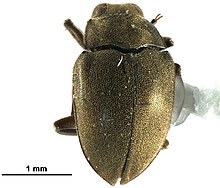Family of beetles
Wikispecies has information related to Lutrochidae.
Lutrochidae is a family of water beetles with a single genus Lutrochus sometimes known as "Travertine beetles". There are around 21 species native to the Americas from the southern United States to Brazil.[1]
They are distinguished by their ovate bodies, 2–6 mm long and yellowish in color, and short antennae in which the first two antennomeres are longer than the others. The larvae are elongate, 4–10 mm in length, with short but well-developed legs.[2]
The adults have a bubble of air held in place by hairs.[1]
The adults and larvae are associated with submerged old and rotting wood found in shallow, fast flowing streams.[1]
References
- ^ a b c Ide, Sergio, Costa, Cleide and Vanin, Sergio Antonio. "Lutrochidae Kasap & Crowson, 1975: Coleoptera, Beetles". Handbook of Zoology Online, edited by Andreas Schmidt-Rhaesa. Berlin, Boston: De Gruyter, 2016.
- ^ William D. Shepard, "Lutrochidae", in Ross H. Arnett, Jr. and Michael C. Thomas, American Beetles (CRC Press, 2002), vol. 2
External links
- Detailed description of Lutrochidae at the Library of Congress Web Archives (archived 2001-11-16)
- a picture at the Wayback Machine (archived 2002-11-22)
Extant Coleoptera families
|
|
|---|
- Crowsoniellidae (Crowsoniella relicta)
- Cupedidae (reticulated beetles)
- Jurodidae (Sikhotealinia zhiltzovae)
- Micromalthidae
- Ommatidae
|
|
|
|---|
| Extant families | - Amphizoidae (trout-stream beetles)
- Aspidytidae
- Carabidae (ground beetles)
- Cicindelidae (tiger beetles)
- Dytiscidae (predaceous diving beetles)
- Gyrinidae (whirligig beetles)
- Haliplidae (crawling water beetles)
- Hygrobiidae
- Meruidae (Meru phyllisae)
- Noteridae (burrowing water beetles)
- Trachypachidae (false ground beetles)
|
|---|
|
|
|
|
|---|
| Bostrichiformia | | Bostrichoidea | - Bostrichidae (auger beetles)
- Dermestidae (skin beetles)
- Endecatomidae
- Jacobsoniidae (Jacobson's beetles)
- Nosodendridae (wounded-tree beetles)
- Ptiniidae (furniture beetles, death watch beetles, spider beetles)
|
|---|
| Derodontoidea | - Derodontidae (tooth-necked fungus beetles)
|
|---|
|
|---|
| Cucujiformia | | Chrysomeloidea | |
|---|
| Cleroidea | |
|---|
| Coccinelloidea | |
|---|
| Cucujoidea | |
|---|
Curculionoidea
(weevils) | - Anthribidae (fungus weevils)
- Attelabidae (leaf-rolling weevils)
- Belidae (primitive weevils)
- Brentidae (straight snout weevils, New York weevil)
- Caridae
- Curculionidae (true weevils, bark beetles, ambrosia beetles)
- Nemonychidae (pine flower weevils)
|
|---|
| Lymexyloidea | - Lymexylidae (ship-timber beetles)
|
|---|
| Tenebrionoidea | - Aderidae (ant-like leaf beetles)
- Anthicidae (ant-like flower beetles)
- Archeocrypticidae (cryptic fungus beetles)
- Boridae (conifer bark beetles)
- Chalcodryidae
- Ciidae (minute tree-fungus beetles)
- Melandryidae (false darkling beetles)
- Meloidae (blister beetles)
- Mordellidae (tumbling flower beetles)
- Mycetophagidae (hairy fungus beetles)
- Mycteridae (palm and flower beetles)
- Oedemeridae (false blister beetle)
- Perimylopidae, or Promecheilidae
- Prostomidae (jugular-horned beetles)
- Pterogeniidae
- Pyrochroidae (fire-coloured beetles)
- Pythidae (dead log bark beetles)
- Ripiphoridae (wedge-shaped beetles)
- Salpingidae (narrow-waisted bark beetles)
- Scraptiidae (false flower beetles)
- Stenotrachelidae (false longhorn beetles)
- Synchroidae (synchroa bark beetles)
- Tenebrionidae (darkling beetles)
- Tetratomidae (polypore fungus beetles)
- Trictenotomidae
- Ulodidae
- Zopheridae (ironclad beetles, cylindrical bark beetles)
|
|---|
|
|---|
| Elateriformia | | Buprestoidea | - Buprestidae (jewel beetles, or metallic wood-boring beetles)
- Schizopodidae
|
|---|
| Byrrhoidea | - Byrrhidae (pill beetles)
- Callirhipidae (cedar beetles)
- Chelonariidae (turtle beetles)
- Cneoglossidae
- Dryopidae (long-toed water beetles)
- Elmidae (riffle beetles)
- Eulichadidae (forest stream beetles)
- Heteroceridae (variegated mud-loving beetles)
- Limnichidae (minute mud beetles)
- Lutrochidae (travertine beetles)
- Psephenidae (water-penny beetles)
- Ptilodactylidae
|
|---|
| Dascilloidea | - Dascillidae (soft bodied plant beetles)
- Rhipiceridae (cicada beetle, cicada parasite beetles)
|
|---|
| Elateroidea | - Artematopodidae (soft-bodied plant beetles)
- Brachypsectridae (Texas beetles)
- Cantharidae (soldier beetles)
- Cerophytidae (rare click beetles)
- Elateridae (click beetles)
- Eucnemidae (false click beetles)
- Jurasaidae
- Lampyridae (fireflies)
- Lycidae (net-winged beetles)
- Omethidae (false fireflies, long-lipped beetles)
- Phengodidae (glowworm beetles)
- Rhagophthalmidae
- Sinopyrophoridae
- Throscidae (false metallic wood-boring beetles)
|
|---|
| Rhinorhipoidea | - Rhinorhipidae (Rhinorhipus tamborinensis)
|
|---|
| Scirtoidea | |
|---|
|
|---|
| Scarabaeiformia | | Scarabaeoidea | - Belohinidae (Belohina inexpectata)
- Bolboceratidae
- Diphyllostomatidae (false stag beetles)
- Geotrupidae (dor beetles)
- Glaphyridae (bumble bee scarab beetles)
- Glaresidae (enigmatic scarab beetles)
- Hybosoridae (scavenger scarab beetles)
- Lucanidae (stag beetles)
- Ochodaeidae (sand-loving scarab beetles)
- Passalidae (betsy beetles)
- Pleocomidae (rain beetles)
- Scarabaeidae (scarabs)
- Trogidae (hide beetles)
|
|---|
|
|---|
| Staphyliniformia | |
|---|
|
|
|
Taxon identifiers |
|---|
| Lutrochus | |
|---|
| Lutrochidae | |
|---|
 | This Elateriformia-related article is a stub. You can help Wikipedia by expanding it. |














